Comet Pons-Brooks, Our Clocks Click Forward, the Moon Appears Pretty, Eyeing Australe, and Stars Guard the Pole Star!
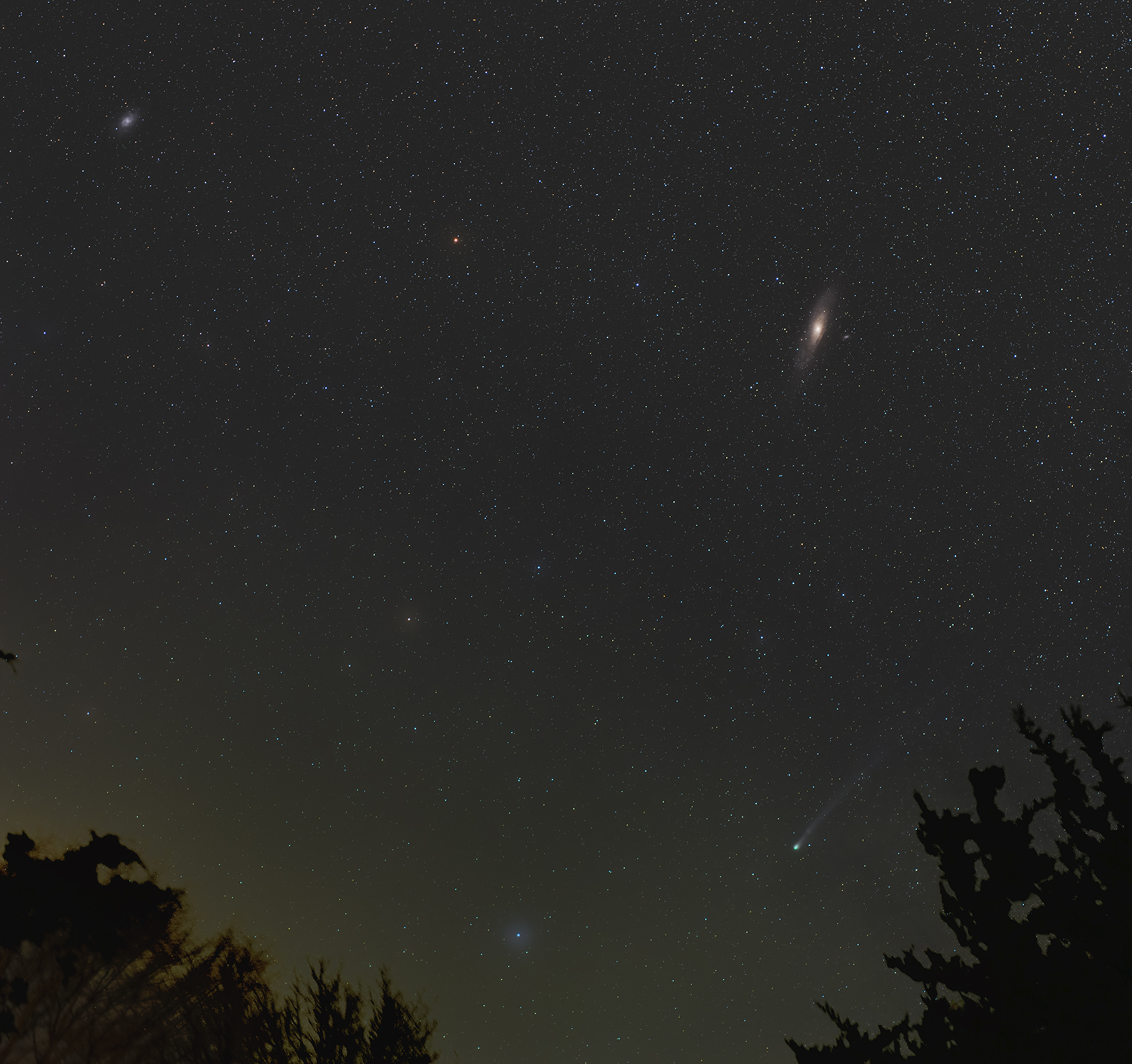
Malcolm Park captured this terrific widefield image of Comet 12P/Pons-Brooks on March 4 2024. The Andromeda Galaxy is prominent at the upper right, and the triangulum galaxy is fuzzy at top left. This week the comet will travel between the two widely separated bright stars Mirach (above centre) and bluish Alpheratz (below centre). Enjoy more of Malcolm’s work on FaceBook.
Hello, Mid-March Stargazers!
Here are your Astronomy Skylights for the week of March 10th, 2024 by Chris Vaughan. Feel free to pass this along to your friends and send me your comments, questions, and suggested topics. You can also follow me on Twitter as @astrogeoguy! Unless otherwise noted, all times are expressed in Eastern Time. To subscribe to these emails please click this MailChimp link.
If you’d like me to bring my Digital Starlab portable inflatable planetarium to your school or other daytime or evening event, or deliver a session online, contact me through AstroGeo.ca, and we’ll tour the Universe, or the Earth’s interior, together! My book with John A. Read entitled 110 Things to See With a Telescope is a guide to viewing the deep sky objects in the Messier List – for both beginners and seasoned astronomers. DM me to order a signed copy!
I share some interesting back-story around the shifting ahead of our clocks. The moon will join the western evening sky this week, posing with planets, offering a peek at its elusive southeastern features, and granting us several good opportunities to catch Comet Pons-Brooks in the west. Mercury will join Jupiter and Uranus in the west after sunset, countering Mars and Venus in the east before sunrise. And I highlight Polaris’ neighbourhood. Read on for your Skylights!
“Spring” Time?
For jurisdictions that employ Daylight Saving Time (or DST, for short), clocks were set forward by one hour at 2 am local time last night, Sunday, March 10. In North America, the “Spring Forward” will remain in effect until Daylight Saving Time reverts to Standard Time when we “Fall Back” on November 3, 2024.
For most of human history people woke with the sun and went to bed at dusk. At equatorial latitudes, where most people lived, hunted, and farmed, the number of hours of daylight through the year didn’t vary too much – so that approach worked well. But, as communities spread around the world and began to use standardize working hours – especially at latitudes farther from the equator where the days lengthened and shortened dramatically throughout the year – people were forced to use artificial light indoors when the sun wasn’t shining into windows.
Scientist/naturalist Benjamin Franklin, in a satire he published while living in Paris in 1784, proposed that Parisians get out of bed earlier to take advantage of the early sunrises in summer – and thereby save money on candles and oil in evening. For the same reason, during the 19th Century it became common for schools and businesses to adjust their operating hours with the seasons – but that practice wasn’t standardized.
New Zealand entomologist George Hudson first proposed what became Daylight Saving Time in 1895 – but he wanted the clocks to shift by 2 hours! The idea then spread to England where prominent English builder and outdoorsman William Willett, who was also an avid golfer, noted that more work (and golf) could be fit into the day if the clocks were advanced during the warm months. While the British parliament toyed with the proposal for years, it was Canada that led the way on Daylight Saving Time!
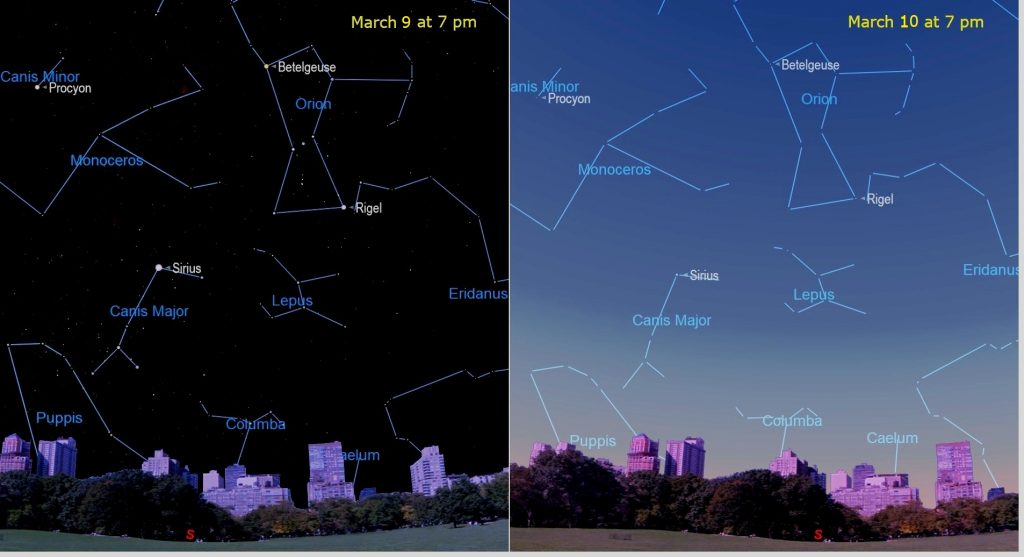
The first city in the world to enact DST, on July 1, 1908, was Port Arthur, Ontario, Canada – followed soon after by Orillia, Ontario. The German Empire and Austria-Hungary adopted DST on April 30, 1916 as a way to conserve coal during World War I. Britain and most of its allies, plus many European neutrals soon followed. The USA adopted DST in 1918. Except for Canada, the UK, France, Ireland, and the United States, DST was abandoned after the war; but it was re-instated during World War II and then widely adopted as a result of the energy crisis of the 1970’s.
The inconvenience of twice-yearly clock changes has led to calls to abandon the practice. Some jurisdictions, including Ontario, Canada and the USA, have proposed to remain on DST year-round. But the proposals that have passed various legislative bodies require the adjoining jurisdictions (New York state and Quebec in the case of Ontario) to make the change, too.
I’d prefer to remain on Standard Time year-round and adjust school and office hours where necessary. For stargazers, advancing clocks by one hour, plus the fact that sunset occurs 1 minute later with each passing day near the March equinox, means that spring and summer star parties and dark-sky observing cannot begin until much later in the evening – usually after the bedtime of junior astronomers! Staying on DST will also mean that existing sundials will be permanently wrong because solar noon will always occur at 1 pm, and not at 12 pm.
The names and abbreviations for time zones change when DST is in effect. Eastern Standard Time (EST) becomes Eastern Daylight Time (EDT) – and so on. For those who deal with the timing of astronomical events, the difference between your local time and the international standard of Greenwich Mean Time (or GMT), and the astronomers’ Universal Time (UT), is reduced by one hour when DST is in effect.

One final thought. If your time zone is broad, covering many degrees of longitude, then, despite sharing the same time on the clock, the sunrise and sunset times can be radically different for locations on the eastern and western edges of your zone. The Eastern Time zone covers nearly two hours’ worth of longitude at the latitudes of Ontario and Quebec! If you want your summer sunsets to occur at the latest possible time, live in the western part of your time zone. If you prefer more daylight in the early morning, live as far to the east in your zone as possible. Trevor at Plateau Astro explained it very well on YouTube here.
The Moon
The moon will return to visibility in the evening sky worldwide this week, but its early-setting, waxing crescent won’t bother anyone’s stargazing until Wednesday and beyond.
At 5:00 am EDT, 2:00 am PDT or 09:00 Greenwich Mean Time this morning (Sunday, March 10), the moon officially reached its new moon phase. At that time it was located in eastern Aquarius, approximately 3 degrees south of the sun. While new, the moon is traversing the space between Earth and the sun. Since sunlight can only shine on the far side of a new moon, and the moon is in the same region of the sky as the sun, our natural satellite becomes completely hidden from view for about a day – unless a solar eclipse occurs, as it will on April 8! This new moon will occur only two hours after perigee, the moon’s closest approach to Earth, producing extra large tides worldwide.
Tonight after sunset, the extremely thin crescent moon will sit a few fingers widths below Mercury. They’ll be just above the western horizon until almost 8 pm local time – but very hard to see. On Monday, the moon’s eastern orbital motion will lift it a fist’s width above Mercury. That moon will be relatively easy to see. If you have an unobstructed and cloud-free view to the west, you might see Mercury around 8 pm. (Mercury will be higher every night this week.)
The moon will spend Monday and Tuesday evening crossing the stars of Pisces (the Fishes). Tuesday’s very slender crescent moon will resemble the Cheshire Cat’s smile when it shines below bright Jupiter – setting up a wonderful widefield photo opportunity in the western sky after sunset on both Tuesday and Wednesday. Watch for Earthshine on the moon. Sometimes called the Ashen Glow or the Old Moon in the New Moon’s Arms, the phenomenon is visible within a day or two of new moon, when sunlight reflected off Earth and back toward the moon slightly brightens the unlit portion of the moon’s Earth-facing hemisphere.
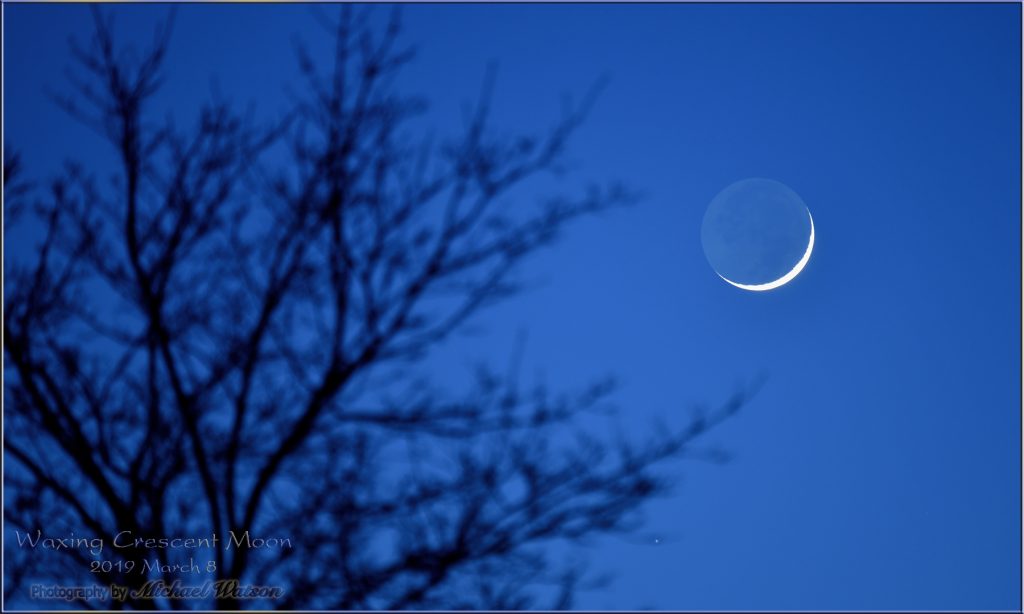
On Wednesday, another 24 hours of travel will lift the pretty, waxing crescent moon beside bright Jupiter in the western sky from dusk to almost midnight. Take a picture of them! Once the sky has darkened, the stars of Aries (the Ram) will appear to the right of them. The faint, distant planet Uranus will be located a palm’s width above (or 6.5 degrees to the celestial east of) Jupiter.
After dusk on Thursday evening, the bright little cluster of stars named the Pleiades, the Seven Sisters, and Messier 45 will be visible sparkling several finger widths above (or 3 degrees to the celestial northeast) of the waxing crescent moon. By the time the pair sets shortly after midnight, the moon will have shifted to the lower edge of the cluster. To better see the Pleiades’ stars, hide the moon beyond the bottom edge of your binoculars’ field of view. The moon will continue to cross through the territory of Taurus (the Bull) on Friday and Saturday night.
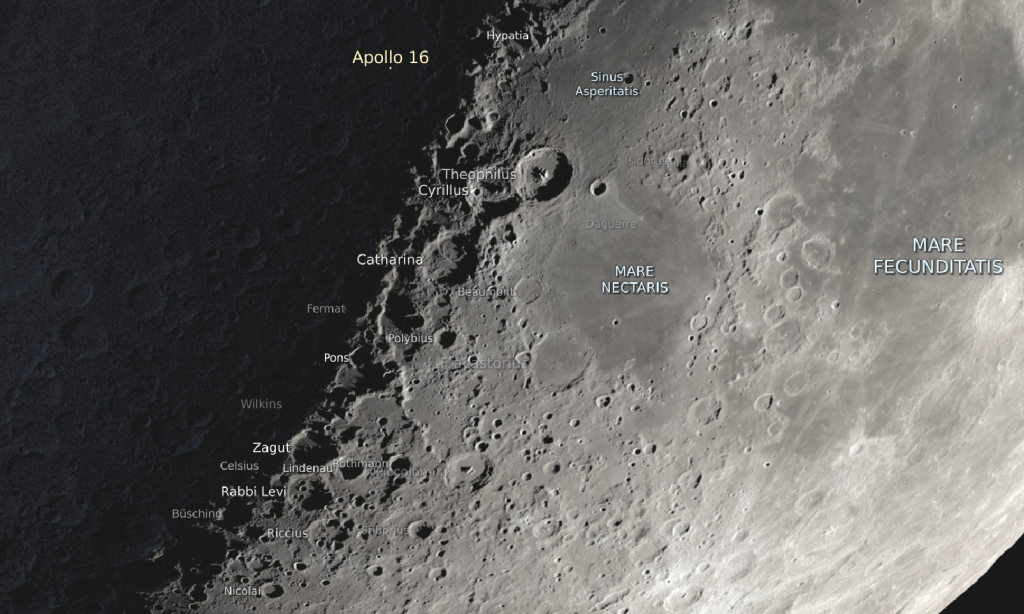
This latter half of this week and into early next week will be the best time to view our natural satellite under magnification. Even binoculars will show the spectacular, lunar terrain alongside the curving terminator boundary. The terminator on Friday’s moon will land just to the west of the curved trio of large craters named Theophilus, Cyrillus, and Catharina that formed outside the western edge of round, gray Mare Nectaris. That mare sits to their lower right (or lunar east). You can tell what order those craters were formed in by observing how sharp and fresh Theophilus’ rim appears, and by the way it has partially overprinted neighboring Cyrillus to its lower right (lunar southwest). Under magnification, Theophilus’ terraced rim and craggy central mountain peak are evident. Cyrillus hosts a trio of degraded central peaks inside a hexagonal rim, while much older Catharina’s peak has been submerged, her edges blurred and her floor overprinted by smaller, more recent craters.
Shift your view up to the right, toward the moon’s high northern latitudes and look for subtle wrinkles curving on the dark floor of the dark mare named Serenitatis and the interesting details inside the big, nearly flooded crater named Posidonius that has been formed along the eastern edge of that ocean of basalt. For scale, that crater is about 100 km across.
Due to the moon’s orbital inclination and ellipticity, it nods up-and-down and sways left-to-right by up to 7 degrees while keeping the same hemisphere pointed towards Earth. Over time, this lunar libration effect lets us see 59% of the moon’s total surface without leaving the Earth. For several nights surrounding Friday, March 15, the moon’s brightly lit southeastern limb will be rotated toward Earth, revealing a collection of dark patches that can be seen in a backyard telescope. Together they comprise Mare Australe “the Southern Sea”. The northern and southern boundaries of the mare are dominated by the isolated dark ovals of the craters Oken and Hanno, respectively. Between them, look for the similar dark craters Brisbane Z and Brisbane E and the large, lighter grey crater Lyot. As the moon descends the western sky during evening, Mare Australe will be on the moon’s bottom edge. The prominent scar of Vallis Rheita “the Rheita Valley” pointing towards the moon’s edge can guide you.

The moon will complete the first quarter of its orbit around Earth, measuring from the previous new moon, at 12:11 am EDT or 04:11 GMT next Sunday. (That converts to 8:11 pm PDT on Saturday evening.) At first quarter, the 90 degree angle formed by the Earth, sun, and moon will cause us to see our natural satellite as a half-moon with its eastern hemisphere illuminated. At this part of the lunar cycle, the moon always rises around noon and sets around midnight, allowing it to be seen in the afternoon daytime sky, too.
Comet Pons-Brooks
A periodic comet named 12P/Pons-Brooks was discovered by Jean-Louis Pons in 1812 and then rediscovered by William Robert Brooks in 1883, giving it its hyphenated name. Similar to Halley’s Comet, it ventures into the inner solar system and passes just inside the orbit of Earth every 71.3 years, and then it heads out beyond the realm of Neptune and Pluto for decades. Its orbit is nearly at right angles to the plane of our solar system, so it would be an excellent candidate for a spacecraft to hitch a ride on, allowing us to sample space around the planets and view the sun and planets’ polar regions, albeit slowly. Last November, I posted a diagram of that geometry here and the link to the simulation here. By the way, Halley’s Comet is formally designated as 1P/Halley because it was the first periodic comet to have its orbit calculated, whereas Pons-Brooks is 12P was the twelfth periodic comet to be so-characterized.
Astronomers used the trajectory of comet Pons-Brooks past the sun and Earth to forecast that it will become bright enough for binoculars and perhaps unaided eyes this spring. Last November, it unexpectedly brightened ahead of schedule in what astronomers call an outburst. The media dubbed it the “Devils’ Comet” because the gas erupted in two spots, forming “horns”.
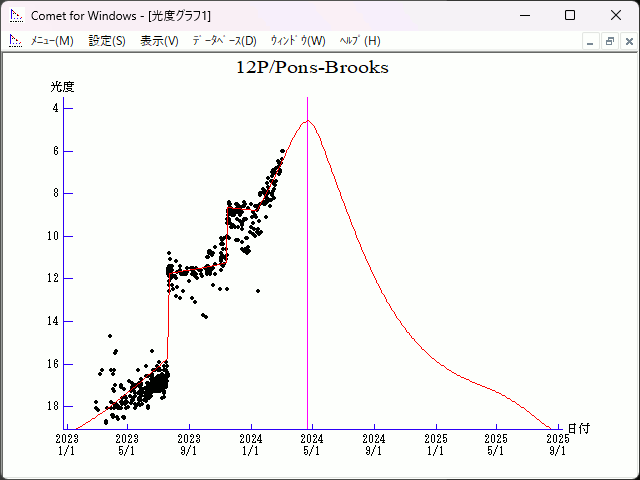
The comet has so-far reached about magnitude 6, which is within reach of any telescope and good binoculars under dark skies. Many of my friends have started to view the comet and capture nice photos of it. If you search for Pons-Brooks on social media, you’ll turn up some nice images already.
For observers in mid-northern latitudes on Earth, the comet will be descending the western sky after dusk every night. The best combination of sky darkness and the comet’s height is around 9 pm in your local time zone. Visually, expect to see a faint, fuzzy smudge that may look greenish in larger telescopes. Its faint tail, best seen in binoculars and long exposure photos, will extend upwards to the right, towards the large Andromeda Galaxy nearby. The comet will set around 11 pm.

Comet Pons-Brooks is fairly easy to find. This week, it will be travelling right-to-left between two bright stars that both shine about three fist diameters to the lower right of Jupiter. Comets boogie! The higher star is Mirach. The large smudge of the Andromeda Galaxy will be located a generous palm’s width to Mirach’s right (or 7.5 degrees to the celestial northwest). The lower star is Alpheratz. Tonight (Sunday) the comet will be positioned a bit less than halfway between those stars. A medium-bright star named Delta Andromedae (or δ And) will shine to the comet’s left in your binoculars.
On each subsequent night, the comet will shift by a finger’s width in the direction of Jupiter (or celestial WSW). It’ll pass above Delta on Wednesday and then slide more and more to the upper left of that star. Try to look for the comet earlier this week before the moon brightens too much. Let me know if you see it!
Pointing at Polaris
Polaris, commonly known as the North Star, sits at the tip of the curved handle of the Little Dipper asterism. The seven stars in the Little Dipper also form the constellation Ursa Minor (the Little Bear). Polaris’ astronomical names include Alpha Ursae Minoris, 1 UMi, and HD 8890, HIP 11767, HR 424. Early astronomers assigned Greek letters to the brightest stars in a constellation, using alpha for the brightest and so on. Those other codes are from the star catalogues named for astronomers Johann Bayer and Henry Draper, the Hipparchus space telescope, and the Harvard Revised Photometry Catalogue, respectively.
Contrary to popular opinion, Polaris is not a prominent star at all. It is a much larger star than our sun, and it emits 2,500 times more light. Its surface temperature is similar to our sun’s. But, since Polaris is located about 430 light-years from Earth, it shines at magnitude 1.95, ranking it only 48th in brightness in the night sky.
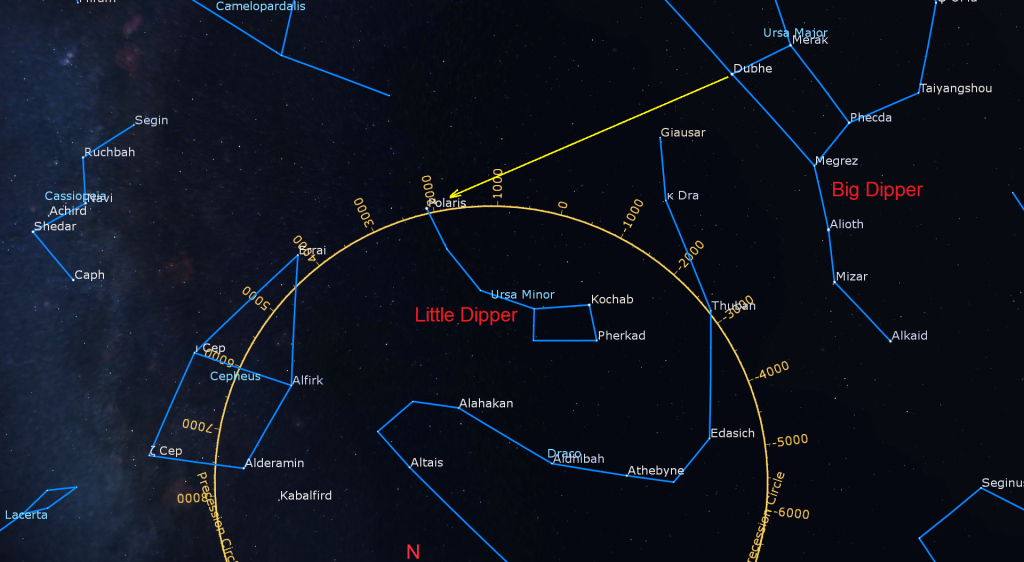
Polaris’ fame is due to its steadfast position over the northern horizon, and its utility for navigation on Earth before the advent of GPS. While the rest of the sky revolves due to Earth’s rotation, Polaris remains anchored in place because it sits less than a finger’s width from the North Celestial Pole (or NCP, for short), the imaginary point in space that the Earth’s axis of rotation points toward. Due to precession, the slow wobble of the Earth’s axis, Polaris will slowly drift even closer to the NCP until the year 2101. The star Thuban in Draco (the Dragon) was the pole star when the pyramids were built. Between about 4000 and 7000 AD, several of the stars in Cepheus (the King) will take turns as Earth’s pole star, although none of those will mark it as precisely as Polaris does.
Recognizing Polaris’ unique position in the heavens, other world cultures have named it accordingly. Medieval Islamic astronomers called it Mismar, meaning “needle” or “nail,” al-kaukab al-shamaliyy “the north star,” and al-kutb al-shamaliyy “the northern axle (or spindle).” The Inuit call Polaris Nuutuittuq or Niqirtsuituq meaning “never moves”. The star is depicted on the flag and coat of arms of the Canadian Inuit territory of Nunavut, as well as on the flag of the U.S. state of Alaska. In traditional Lakota star knowledge, Polaris is named Wičháȟpi owáŋžila “the Star that Sits Still”.

You can measure your latitude on Earth by measuring how many degrees above the horizon Polaris is. A clenched fist held at arm’s length covers ten degrees of the sky. Count the number of fist diameters between the horizon and Polaris. Combine that knowledge with the fact that the point on the horizon directly below Polaris marks geographic north, and you’re well on your way to figuring out your location on Earth – at least, that’s what folks did before GPS! (Don’t forget that compasses measure magnetic north, which can be different from geographic north.)
Polaris can easily be seen with your unaided eyes in a moderately dark sky. If you don’t already know your latitude and the direction of north, the easiest way to find Polaris is by using two stars in the Big Dipper’s bowl. During evening in March the dipper is standing upright on its handle in the northeastern sky. Join an imaginary line from Merak (the bottom of the bowl) to Dubhe (“DOO-bee”, at the rim of the bowl) and keep going. The next obvious star will be Polaris. It’s about three fist diameters away from Dubhe. Don’t forget that the Big Dipper, like everything else in the sky, circles around Polaris continuously. During some parts of the year you’ll be drawing that line upwards, and at other times toward the left or the right. Merak and Dubhe are often referred to as the Pointers. I’ll put a sky chart of the area here.
In early-March at around 8 pm local time, the Little Dipper pattern curves down and to the right from Polaris. Continuing that arc upwards to the right will lead you towards the Big Dipper. The two dippers fall on either side of the tail stars of Draco (the Dragon). The magnitude 2.06 star at the outer edge of the Little Dipper’s bowl (and closest to the Big Dipper) is named Kochab. This K-class, reddish star is slightly fainter than Polaris. The white, magnitude 3 star below Kochab is Pherkad, or Gamma Ursae Minoris. A fainter orange companion shines near Pherkad. The other four stars of Ursa Minor may be too dim to see from the city with unaided eyes, but binoculars will reveal them. Kochab and Pherkad are sometimes called the Guardians of the Pole.
If you have a telescope, aim it at Polaris and look for a tiny, white star named HIP 7283 that sits close to yellow-tinted Polaris. As before, the rotation of the sky can place that little star anywhere on a circle surrounding Polaris. On early-March evenings, it will be to Polaris’ lower left, but your telescope’s optics will probably flip and/or mirror that orientation. You can connect that little star with a number of other stars to form a small, roughly circular ring of stars a finger’s width across. It’s on the side of Polaris opposite to Kochab. It’s called the Engagement Ring, and Polaris is the diamond. Let me know if you see it!
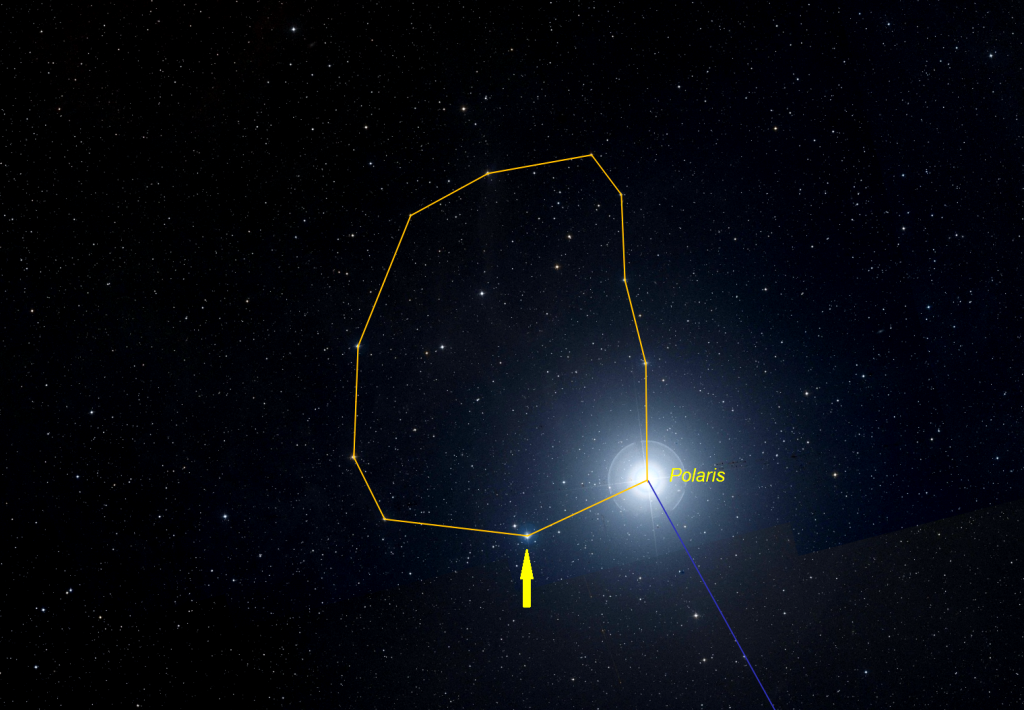
Stargazing Sights for Mid-March
With the moon barely in the evening sky until mid-week, you can still explore the wonders of the late winter sky in binoculars and backyard telescopes. Last week, I highlighted some the best sights here. By the way, Mother Nature decided we needed cloudy skies this weekend, quashing the Messier Marathon plans I mentioned last week. Let me know if you did one.
The Planets
Three planets will be available for viewing after sunset this week.
Mercury will appear over the western horizon after sunset every night. Its magnitude -1.3 speck can be teased out of the surrounding twilight, but wait until the sun has fully set before searching with binoculars. Mercury will be climbing farther away from the sun each night, rapidly ascending above a nearly vertical evening ecliptic, producing the best evening appearance of the planet in 2024 for Northern Hemisphere observers, but a very poor one for those in the Southern Hemisphere. The planet will be waning in illuminated phase and diminishing in brightness all month long. Mercury will reach peak visibility around mid-month, when it will show a gibbous, football shape in telescopes, shine at magnitude -1.0, and set about 80 minutes after the sun. There is no rush to see Mercury this week, but you may wish to spot its meeting with the young moon that I described above.
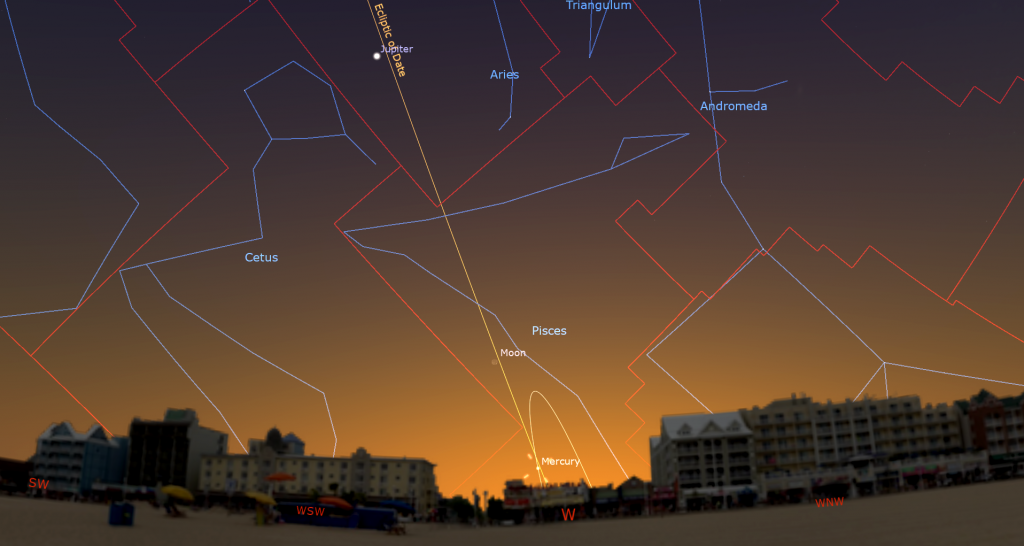
While you are looking for Mercury after sunset, brilliant Jupiter will become visible about halfway up the western sky. Just turn your gaze upwards! Unlike too-low-in-the-sky Mercury, Jupiter will continue to be a great target for any telescope. If you view Jupiter while it’s higher in the sky, it’ll appear look better in a telescope. Under steady air conditions, you’ll get reasonable views of Jupiter in any telescope until about 9:45 pm local time (now that clocks have changed). Then the planet will set in the west around 11:45 pm local time. The bright stars of the winter constellations will be arrayed off to Jupiter’s upper left (or celestial southeast). Jupiter will be creeping slowly upward (celestial eastward) through Aries (the Ram).
Any decent pair of binoculars can show you Jupiter’s four largest Galilean moons lined up on both sides of the planet. Named Io, Europa, Ganymede, and Callisto in order of their orbital distance from Jupiter, those moons complete orbits of the planet every 1.7, 3.6, 7.2, and 16.7 days, respectively. If you see fewer than four moons, then one or more of them is crossing in front of or behind Jupiter, or hiding in Jupiter’s dark shadow – or two of the moons are very close together or occulting one another. All four moons will huddle close to Jupiter on Monday evening.
A small telescope will reveal Jupiter’s dark belts and light zones, which are aligned parallel to its equator. With Jupiter is descending in the west these days, its stripes are tilted upright. With a better grade of optics, Jupiter’s Great Red Spot, a cyclonic storm that has raged for hundreds of years, is visible for several hours when it crosses the planet every 2nd or 3rd night. GRS appearances are fewer when the planet is only visible for a few hours each night. For observers in the Americas, the GRS will cross Jupiter’s disk in mid-evening Eastern Time on Monday, Thursday, and Saturday. The spot has been rather a pale pink in colour for some time now. If you have any coloured filters or nebula filters for your telescope, try enhancing the spot with them.
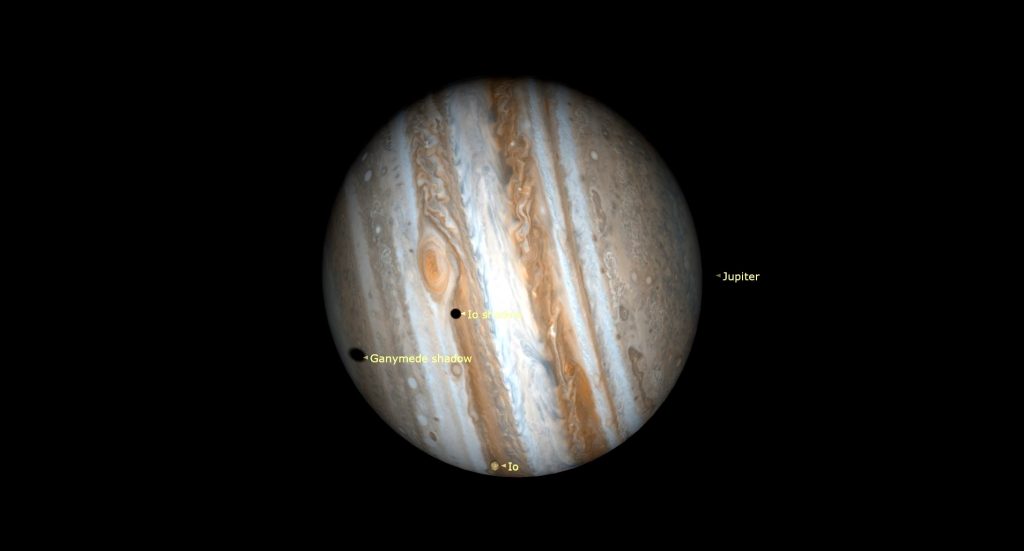
From time to time, observers with good quality telescopes can watch the small, round, black shadows of the Galilean moons as they traverse Jupiter’s disk. On the evening of Monday, March 11, observers located in Central Asia can watch two shadows crossing the southern hemisphere of Jupiter, and the Great Red Spot, all at the same time. At 8:10 pm India Standard Time (or 14:40 GMT), the large shadow of Ganymede will appear near Jupiter’s southern pole and Io’s small shadow and the Great Red Spot will begin to cross Jupiter’s southern equatorial region. Ganymede’s shadow will complete its shorter trip at 9:45 pm IST (or 16:15 GMT). Meanwhile, Io’s shadow will outpace the GRS and depart from Jupiter at 10:18 pm (or 16:50 GMT), around the time that the planet will be setting.
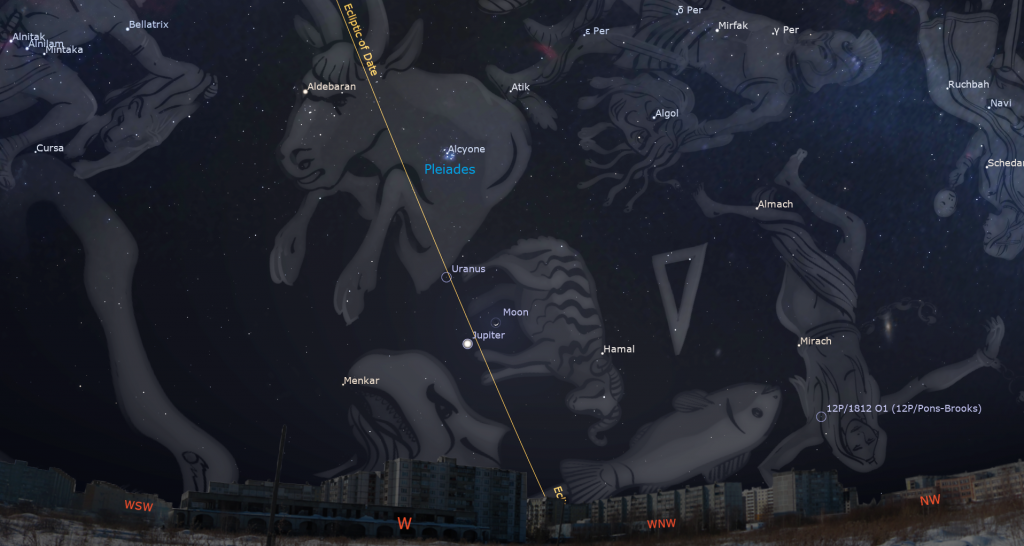
Uranus is the third evening planet we can see nowadays. Its blue-green speck is trailing about 35 minutes behind Jupiter on the ecliptic, so it will be visible until about 10:30 pm. The magnitude 5.8 planet is quite easy to see in binoculars and backyard telescopes when the moon isn’t too bright. Look for Uranus a flat palm’s width to Jupiter’s upper left (or 6.5° to its celestial east). Uranus will also be positioned about two finger widths to the lower left of a medium-bright star named Botein (or δ Arietis). The bright Pleiades star cluster will sparkle a bit more than a fist’s width above Uranus (or 11.5° to its celestial northeast). Since Jupiter is closer to the sun than Uranus, its faster motion will carry it steadily closer to Uranus every night until they kiss in twilight on April 20.
The next planet to rise will be Mars – at about 6:30 am local time. By 7 am, the far brighter planet Venus will join it, but you may need to walk around to see them between trees or buildings. Skywatchers living closer to the tropics will see Mars and Venus (and that old moon) more easily. After kissing in late February, Venus and Mars are separating. Due to Earth’s orbital motion, Mars is being carried away from the sun, along with the surrounding stars of Capricornus (the Sea-Goat). Meanwhile, Venus’ own orbit is carrying it the opposite direction, eventually to a solar conjunction in early June. Though Venus will soon exit the morning sky, Mars will stick around all year – moving into evening in September.
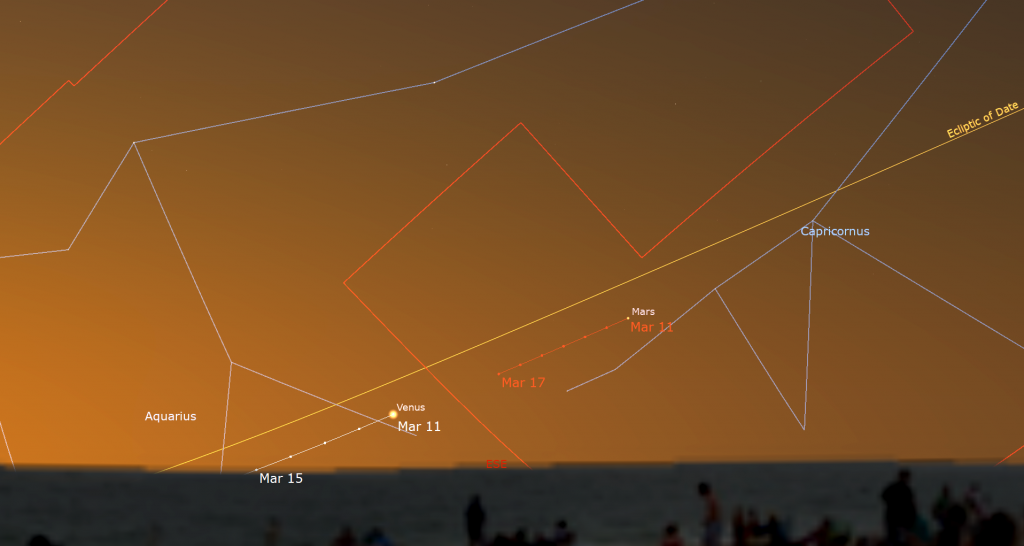
Public Astronomy-Themed Events
Every Monday evening, York University’s Allan I. Carswell Observatory runs an online star party – broadcasting views from four telescopes/cameras, answering viewer questions, and taking requests! Details are here. They host in-person viewing on the first clear Wednesday night each month. Other Wednesdays they stream views online via the observatory YouTube channel. Details are here.
It’s March Break week in Ontario! Many astronomy-focused groups are presenting family-friendly space and planets events in the GTA. Some are focused on the April 8 solar eclipse. You can view a list of the RASC Toronto Centre events at https://rascto.ca/events.
On Friday, March 15 at 12:30 pm, I will set up my Starlab portable planetarium in the Collingwood Public Library to explore the Universe. We’ll tour the night sky and see close-up views of galaxies, nebulas, and star clusters, view our Solar System’s planets and alien exo-planets, land on the moon, Mars – or the Sun, travel home to Earth from the edge of the Universe, hear indigenous starlore, and watch immersive fulldome movies! Ask me your burning questions, and see the answers in a planetarium setting – or sit back and soak it all in. Details and registration are here.
On Friday, March 15 from 8 to 10 pm, RASC Toronto Centre will host Family Night at the David Dunlap Observatory for visitors aged 7 and up. You will tour the sky, visit the giant 74” telescope, and view celestial sights through telescopes if the sky is clear. This program runs rain or shine. Details are here, and the link for tickets is here.
Spend some time in the other dome at the David Dunlap Observatory! On Saturday, March 16, visitors can join me in my Starlab Digital Planetarium for an interactive journey through the Universe at DDO. We’ll tour the night sky and see close-up views of galaxies, nebulas, and star clusters, view our Solar System’s planets and alien exo-planets, land on the moon, Mars – or the Sun, travel home to Earth from the edge of the Universe, hear indigenous starlore, and watch immersive fulldome movies! Ask me your burning questions, and see the answers in a planetarium setting – or sit back and soak it all in. Please note that all guests will sit on a clean floor. A registered adult must accompany all registered participants under the age of 16. We run two morning sessions for Junior Astronomers and two afternoon sessions for all ages. More information and the registration links for the morning sessions are as follows: 9:30 am session ActiveRH and 11:15 am session ActiveRH. The afternoon session link is at ActiveRH.
At the Ethennonnhawahstihnen branch of the Toronto Public Library on Saturday, March 16 at 2 pm, RASC astronomers will deliver a free public presentation about the April 8 solar eclipse. More details are here.
Keep your eyes on the skies! I love getting questions and requests. Send me some!